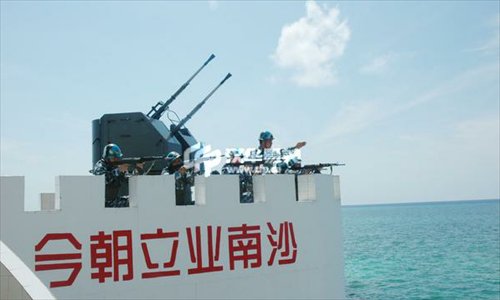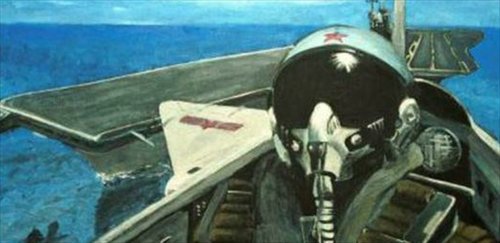Web users commemorate pilot killed in China-US fighter crash as tensions run high
Every year on April 1, many Chinese online users commemorate the passing of Chinese air force pilot Wang Wei who died when his fighter jet collided with a US military reconnaissance aircraft in the South China Sea. As tensions in the South China Sea are running high, this year's online commemoration has attracted more people's attention with mixed feelings of pride in the PLA's improved capabilities and indignation over what they see as incessant provocations.

Chinese soldiers train on a reef in the South China Sea. Photo: CFP
"81192, the Liaoning has cleared its deck, please return!"
During the national holidays held for China's Qingming festival, or tomb-sweeping day, an article with this headline went viral online.
Many Net users and institutes reposted it on their Sina Weibo and WeChat accounts and it has since been read and commented on tens of thousands of times.
The 81192 was a fighter jet of China's People's Liberation Army (PLA) air force which crashed into the EP-3, a US Air Force reconnaissance plane that was on a mission in the South China Sea on April 1, 2001.
"If you are still in the airspace to intercept the US plane, please mind your fuel to return to Lingshui airport directly or let me guide you to the Liaoning aircraft carrier for landing … 81192, please answer if you copy."
Thousands of Chinese netizens reposted this message and similar posts or left comments on them, which were apparently unable to reach the destroyed plane.
The 81192 was sent to intercept the US spy craft within a proclaimed Chinese exclusive economic zone (EEZ) when the collision occurred and killed Chinese Lieutenant Commander Wang Wei, pilot of the 81192.
The incident caused a major diplomatic crisis between China and the US over who should take responsibility for the deadly crash.
As the US and the Philippines began joint military exercise Monday in the South China Sea, it is clear that tension still runs high in the region, and not much has improved since the crash 15 years ago.
Zhang Zhaozhong, a retired military expert at the PLA National Defense University, wrote an article for news portal Sina's military channel, explaining what happened that day and why it has an impact on future military development in China.
He wrote that the US jet was used mainly for electronic reconnaissance and this type of plane is usually connected with spying missions.
The handling of this incident by the Bush administration further strained the situation. The US military sent three vessels from near Hong Kong to the waters where the crash happened to put more pressure on China, as well as sending five reconnaissance planes into China's EEZ, Zhang wrote.
"The plane crash is connected with the US' strategy to contain and control China. According to the US military's new strategic planning, it will enhance military deterrence, strait passage protection and vessel and plane trailing in Asia Pacific, especially in waters neighboring China," he wrote. "We must be highly alert and develop ourselves, in order to protect our own sovereignty and integrity."

A drawing by an anonymous netizen shows pilot Wang Wei in his J-8 fighter jet, with the Liaoning aircraft carrier in the background
Proud posts
Since the incident, online posts and articles have appeared every anniversary, which pay tribute to Wang, who many see as a martyr that died to safeguard China. Such posts are more frequently seen in recent years as China's military grows larger and more developed, especially after China's first aircraft carrier the Liaoning began service in 2012.
In the online posts, authors introduce the life of Wang Wei, who was born in 1968 and joined the PLA after graduating from high school. His widow and son were received by then President Jiang Zemin at the time of the crash, and he was glorified as a national hero.
In the collision incident, China sees itself as a victim and the US as a bully which caused trouble on China's doorstep. This sentiment was widely shared by ordinary Chinese who view the plane collision and the attitude of the US as disrespectful.
Many netizens blame China's weak national defense capability for failing to deter the US from sending its planes into waters adjacent to China.
This could also be seen in the patriotic online posts. In these tributes, netizens often say that they hope to see China's military grow stronger.
Under a news article commemorating Wang Wei, one netizen commented, "At that time, US power was at its peak. Russia was weak, and so was China. At that time, we couldn't afford to cross paths with the US, and we sacrificed hero Wang Wei. But we swallowed the shame in order to avenge it someday … we hope our country will be stronger!"
"Wang Wei sacrificed himself to protect our country's sovereignty. It's because of people like him that we can have our peaceful lives. Hail to the hero!" another wrote.
While remembering Wang, some netizens praised the PLA's increasing power and China's latest weaponry, especially highlighting the Liaoning aircraft carrier which is seen as a symbol of the country's developing national defense capability.
"We will never forget April 1, neither will we forget the need to greatly boost national defense," one of the posts read.
The posts reflect upon China's military achievements, from senior Chinese military officials visiting a US aircraft carrier, to the process of China manufacturing the J-10, J-15 and J-20 fighter planes.
China bought a retired aircraft carrier from Ukraine in 2002 which was renovated and renamed the Liaoning. The Ministry of National Defense verified at the end of last year that construction is underway of a new, more advanced carrier.
Some online posts took the opportunity to express pride in news about China turning rocky outcrops in the South China Sea into islands, and comparing China-controlled islands with those controlled by other countries.
Trust construction
This event had a significant impact on the development of Sino-US ties.
In November 2007, the first military hotline between China and the US was established. It was the first hotline established between the PLA and the foreign military force.
According to media reports at that time, many hoped the establishment of the hotline could enhance communications between the two countries' militaries and increase dialogue, in order to boost trust and properly deal with any crisis or accident.
In 2013, Chinese State Councilor and Defense Minister Chang Wanquan and US Defense Secretary Chuck Hagel met in the Pentagon. The two countries' willingness to address their inter-military ties and their efforts to advance toward the goal of building a new-type Sino-US military were discussed.
However, the atmosphere in the troubled South China Sea has become tense again in recent years with an increasingly assertive China protecting the territory it claims in the region and the US's "pivot to Asia" adding to the geopolitical complexity.
US naval ships have sailed within 12 nautical miles of China-claimed islands in the region to demonstrate what it calls "free navigation" around the disputed islands which prompted protests and fierce criticism from China.
Two US B-52 bombers flew over near islands that China claims on December 10 last year, but the Pentagon explained that this was not a planned move.
Such acts have shrouded the South China Sea with military uncertainly, despite the steps taken to increase military trust since Wang's death.
Global Times
Deadly collision
On the morning of April 1, 2001, China sent two J-8 fighter planes to intercept the larger, but less maneuverable EP-3 which was flying around 110 kilometers southeast of South China's Hainan Province.
The J-8s flew close to the US plane, and the 81192 and the EP-3 collided. The 81192 was cut in half by the EP-3's propeller and its pilot, Lieutenant Commander Wang Wei, ejected from the plane before it fell into the sea. Following a massive search effort that failed to locate any trace of Wang, the Central Military Commission on March 14 declared Wang a martyr. The seriously damaged US vessel landed in Hainan's Changshui airport without Chinese approval.
All 24 crew on the US plane arrived safely in Hainan and were taken care of in China before they were allowed to return to the US following interrogation.
A major diplomatic crisis ensued between China and the US following the crash. The J-8 crash site was within a proclaimed Chinese exclusive economic zone (EEZ). China views the electronic reconnaissance activities carried out by the US plane as being illegal, citing the United Nations Convention on the Law of the Sea (UNCLOS), which China argues allows foreign military airplanes and vessels to pass through another country's EEZ but prohibits military activities during the passing process. Therefore China asserts that the US side should take most of the responsibility for the crash.
The US maintains that the UNCLOS provisions for free navigation extend to military craft on missions in the EEZ of another country.
China and the US exchanged accusations over the following months, as the two sides were split over whether the Chinese fighter plane or the US spy craft caused the collision. China blames the US vessel for causing the crash and the death of the Chinese pilot and demanded an apology from the US. The US never officially apologized over the incident instead expressing "regret," as American officials argue that the Chinese pilot caused the crash and that the US side was within its rights to operate in the area.
The black boxes of both the 81192 and EP-3 were acquired by the Chinese military but have never been released.
Newspaper headline: Constant reminder